Endovenous Laser Treatment
Home » Treatments » Endovenous Laser Treatment
Award winning dermatology service, with over 20 years on experience
Short waiting lists, on some occasions offering same week appointments
Safe environment, in Care Quality Commission approved facilities
Conditions:
What is Endovenous Laser ABLATION (EVLA)?
Endovenous Laser Ablation (EVLA) is a minimally invasive procedure for treating varicose veins and venous insufficiency. It is a walk-in and walk-out service under local anaesthetic. Using laser energy, the affected veins are closed and sealed from within. EVLA is widely considered a safe and effective alternative to traditional vein stripping, offering benefits such as faster recovery time, minimal scarring, and a lower risk of complications. Endovenous Laser Ablation is rated by NICE as the Gold Standard, with success rates over 98%.
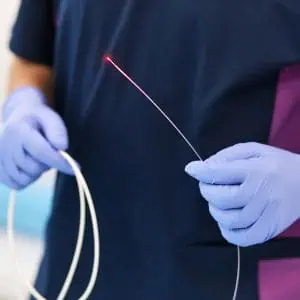
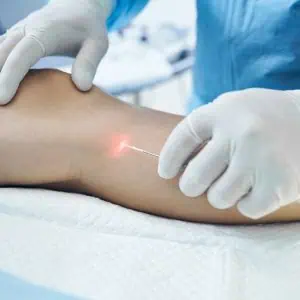
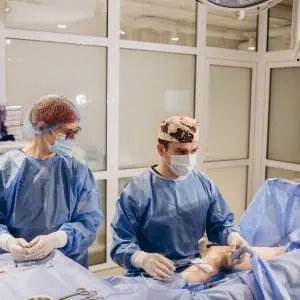
ENDOVENOUS LASER PROCEDURE
Endovenous Laser Ablation (EVLA) is typically carried out under local anaesthetic as a convenient “walk-in, walk-out” procedure, allowing patients to return home the same day. This eliminates the risks and costs associated with general anaesthesia. The process begins with the surgeon mapping out the problematic veins using Duplex Ultrasound for precise planning. While bulging surface varicose veins are not directly treated with EVLA, these can be addressed subsequently with complementary procedures.
During the treatment, a needle is carefully inserted into the targeted vein near the knee or ankle under ultrasound guidance. A thin wire is passed through the vein, followed by a long sheath—a small, flexible tube comparable in size to a pen refill—which is precisely positioned using ultrasound imaging. At this stage, tumescent anaesthesia is injected around the vein for three crucial reasons. It numbs the area to ensure the procedure is painless, compresses the vein around the laser sheath for optimal treatment efficiency and shields surrounding tissues from the laser’s heat.
Once the tumescent anaesthesia is in place, a laser fibre is threaded through the sheath and guided to the top of the vein. The laser is then activated, and as the sheath and fibre are withdrawn in a controlled manner, the targeted vein is sealed shut. Over time, the treated vein is naturally reabsorbed by the body, making EVLA an effective and minimally invasive option for managing varicose veins.
WHAT ARE THE BENEFITS OF EVLA?
Endovenous Laser Ablation (EVLA) offers numerous advantages for individuals with varicose veins:
- 98%+ Success Rate – One of the most effective and reliable treatments for varicose veins
- Minimally Invasive – No large incisions or extensive recovery periods
- Quick Recovery – Most patients resume normal activities within a day or two
- Highly Effective – Ensures long-term relief from pain, swelling, and heaviness in the legs
- Safe & Long-Lasting Results – Provides proven long-term relief with minimal disruption to daily life
- Minimal Scarring – Uses a targeted approach and ultrasound guidance, making it a cosmetically appealing solution
- Lower Risk of Complications – Precise treatment reduces the risk of infection, nerve damage, or recurrence.
- Comfortable Procedure – Tumescent anaesthesia numbs the area, improves laser contact, and protects surrounding tissues
- NICE Gold Standard Treatment – Recognised by the National Institute for Health and Care Excellence (NICE) as the Gold Standard for varicose vein treatment
Is EVLA treatment suitable for all types of varicose veins?
The EVLA (Endovenous Laser Ablation) procedure is predominantly intended to treat saphenous vein reflux, a common cause of varicose veins. However, it may not be appropriate for all varicose vein varieties. The suitability of EVLA depends on several factors, including the veins’ size, location and underlying cause.
How Does endovenous laser treatment work?
How many sessions of EVLA treatment are typically required?
How long does an endovenous laser treatment session typically take?
ARE THERE ANY RISKS OR SIDE EFFECTS ASSOCIATED WITH EVLA TREATMENT?
The potential risks and side effects of EVLA include pain and discomfort, bruising and tenderness, swelling (edema) and inflammation, numbness or altered sensation and skin discolouration.
IS EVLA TREATMENT PAINFUL?
Frequently Asked Questions
IS EVLA TREATMENT EFFECTIVE FOR VARICOSE VEINS?
Yes, Endovenous laser treatment (Endovenous Laser Ablation – EVLA) is regarded as an effective treatment for varicose veins. Due to its efficacy and minimally invasive nature, it has become a popular and widely accepted alternative to conventional surgical procedures such as vein removal. It has been demonstrated that EVLA treatment has a high success rate in closing and treating varicose veins.
HOW LONG IS THE RECOVERY PERIOD AFTER EVLA TREATMENT?
The recovery period following EVLA (Endovenous Laser Ablation) treatment for varicose veins is typically shorter compared to conventional surgical procedures. Although individual experiences may differ, the majority of patients can anticipate a relatively rapid recovery.
CAN I RESUME NORMAL ACTIVITIES IMMEDIATELY AFTER EVLA TREATMENT?
Almost immediately after EVLA (Endovenous Laser Ablation) treatment, the majority of patients can resume normal activities. Unlike conventional surgical procedures for varicose veins, EVLA is a minimally invasive procedure that typically permits a speedier recovery.
ARE THE RESULTS OF EVLA TREATMENT PERMANENT?
The results of EVLA (Endovenous Laser Ablation) treatment for varicose veins are typically permanent, but it is important to note that new varicose veins can develop over time. While the treated vessels are effectively closed off during EVLA, the formation of new veins can be influenced by genetics, lifestyle choices, hormonal fluctuations, and ageing.
CAN PREGNANT WOMEN UNDERGO EVLA TREATMENT?
Pregnant women are not typically advised to undergo EVLA (Endovenous Laser Ablation) therapy. During pregnancy, the body undergoes a number of hormonal and physiological changes that can contribute to the onset or exacerbation of varicose veins. However, EVLA treatment is typically postponed until after pregnancy and lactation have concluded.
CAN EVLA TREATMENT BE COMBINED WITH OTHER VEIN TREATMENTS?
Yes, EVLA (Endovenous Laser Ablation) treatment can be combined with other vein treatments, based on the particular requirements and characteristics of the varicose veins being treated. Combining therapies can improve outcomes and address multiple facets of vein disease.
REQUEST A CALL BACK
Please fill in this form and one of our team will give you a call back to arrange a consultation with one of our expert dermatologists.
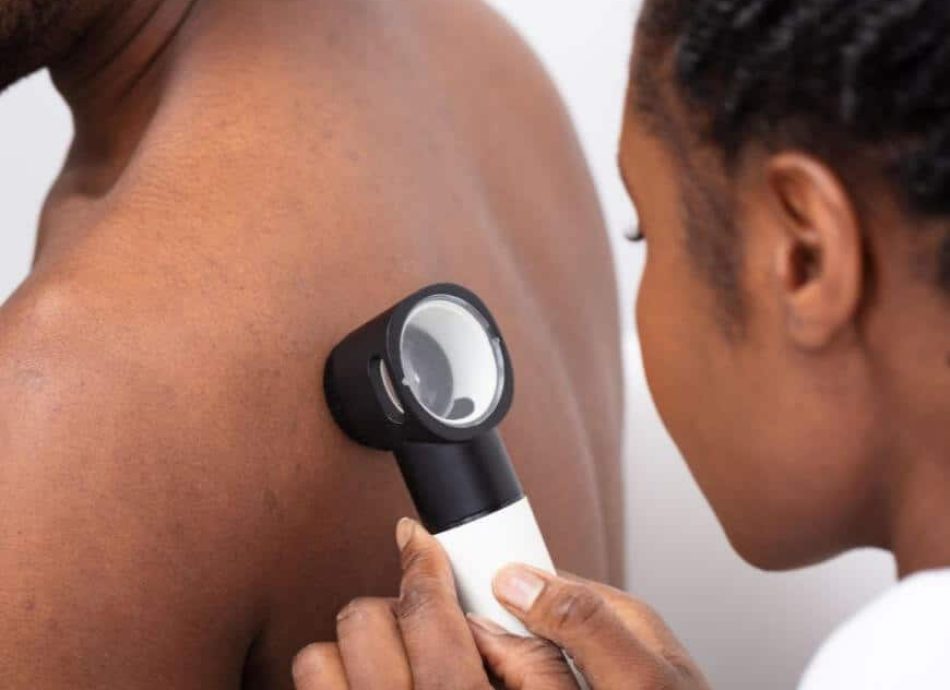
HEAR FROM OUR PATIENTS
WHY CHOOSE endovenous laser treatment FROM STRATUM DERMATOLOGY CLINICS?
INSIGHTS AND ADVICE
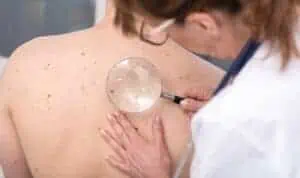
When Should I Worry About A Mole
WHEN SHOULD I WORRY ABOUT A MOLE? A mole is a coloured spot on the skin which is made up of a cluster of cells known as melanocytes which are responsible for producing the pigment in your skin. Sometimes these melanocytes grow in a cluster
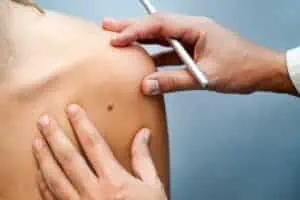
What are the common types of skin cancer?
WHAT ARE THE COMMON TYPES OF SKIN CANCER? There are three main types of skin cancer, basal cell carcinoma (BCC), squamous cell carcinoma (SCC) and melanoma. The first two are both known as non-melanoma skin cancer and are the most common varieties. Non-melanoma skin cancer
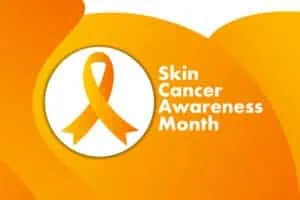
Skin Cancer Awareness Month
Skin cancer awareness month takes place every May with the aim of raising awareness of the dangers of unprotected sun exposure and educating on the ways skin cancer can be prevented. During skin cancer awareness month, the British Association of Dermatologists (BAD) also runs a